|
The Origins of the Palomino Tennessee
Walking Horse
by
Harold Dean Givens
©
Copyright 1991, Voice of the Tennessee Walking Horse, Lewisburg,
Tennessee
Reprinted with permission from The
Voice
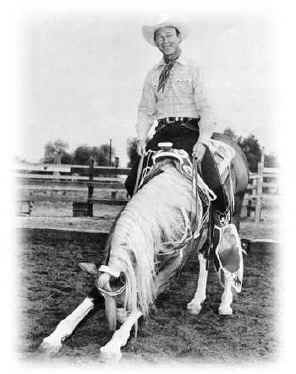 The
well known mount of Roy Rogers, Trigger Jr. (registered
Allen's
Gold Zephyr) was the most famous of all yellow horses. He was
foaled in 1941, the produce of
Barker's Moonbeam and Fisher's Gray
Maud. The
well known mount of Roy Rogers, Trigger Jr. (registered
Allen's
Gold Zephyr) was the most famous of all yellow horses. He was
foaled in 1941, the produce of
Barker's Moonbeam and Fisher's Gray
Maud.
Many theories exist why golden horses with white
manes and tails are called "palominos." Palomino is a moderately
common family name in Spain. It is not improbable that someone
having this name owned a golden horse with a white mane and tail.
This horse could have been called "el Caballo de Palomino" (the
horse of Palomino) which was eventually shortened to palomino.
Another possible origin suggests the name came from "paloma," the
Spanish word for dove or pigeon. A third possibility is that the
name was taken from a certain Spanish grape, said to be golden in
color.
Palominos have ancient origins, proof is evident in
various art work: Rembrandt's "The Rape of Europa," painted in
1632, depicts four palomino horses; the painting "Hunting in Lo
Tai" portrays an emperor of China astride a golden palomino. There
are historical references before the sixteenth century of the
palomino. Cortez brought palominos from Spain to Mexico in 1519
and used them during the invasion.
Palominos in the United
States before 1900 were found mostly in Arizona, California,
Colorado, New Mexico, and Texas. They were frequently designated
"flaxies" or "claybanks" and were called their "Sunday" horses by
the cowboys and ranch men who rode them.
The offspring of
palominos range in color from cremello, yellow, perlino, grulla
and dun to buckskin as well as the usual black, bay, brown,
chestnut, sorrel, gray, yellow, white and various colors of roan.
They have a distinctive golden colored hair (like a newly minted
gold coin) with white, silver or ivory manes and tails and
particular white markings. Some breeders believe their coloration
was inherited from the Spanish Barb.
The Tennessee Walking
Horse Breeders' and Exhibitors' Association originally registered
the palomino horse as yellow. In May 1990, the TWHBEASM
changed the color code back to palomino. From the origin of the
Tennessee Walking Horse Breeders' AssociationSM in 1935
through 1947, there were only two and one-third percent yellow of
all the horses registered.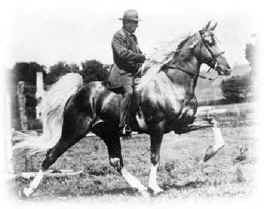
Golden Lady (#350031), foaled in 1913, is the
oldest registered yellow horse, being the second yellow horse
registered by the Association. Her breeder was J. D. Posten,
Bunker Hill, Tennessee, and she was the property of B. C. Hunter
and Son of Lewisburg, Tennessee when she was registered. She was
the dam of eleven foals with the following three being yellow:
Golden Girl (#350019), mare, foaled 1923, by
Hunter's Allen
F-10;
Golden Sunshine (#F-44), stallion,
foaled 1925, also by
Hunter's Allen; and
Yellow Jacket (#360141), stallion, foaled
1936. B. C. Hunter and Son were the breeders of all three.
Golden Girl, out of
Golden
Lady, was the first yellow horse
registered by the Association. She produced five foals, two of
which were yellow: Giovanni's Golden King (#370401), stallion,
foaled 1937, by Giovanni, C. B. Whitworth, breeder; and Golden
Girl II (#470575), mare, foaled 1946, by Head Man, Porter R.
Rodgers, breeder.
Golden Sunshine F-44
(gelded in 1929), also out of
Golden
Lady, was the only yellow
foundation horse out of 115 foundation horses recognized by the
TWHBEASM.
The Tennessee State Fair Horse Show in
Nashville was the largest walking horse show prior to the
Celebration, which was begun in 1939 in Shelbyville, Tennessee. In
1932,
Golden Sunshine
was second in the Tennessee State Fair
Championship Class. (Rambling Boy, a sorrel full brother to
Golden Sunshine, also a gelding, won this same
show in 1929.) Their sire,
Hunter's Allen F-10, a golden chestnut, won the
stallion class five times and the championship once at the State
Fair. He sired six sons and daughters that won nine State Fair
Championships from 1912 through 1938.
Last Chance, the
sire of
Yellow Jacket, was sired by
Hunter's Allen
F-10 in 1931. Last Chance
was chestnut with both hind socks, strip, and flax mane. An
exceptional two-year-old show horse, he went on to place fifth in
the 1939 Celebration's Four-Year-Old and Over Class. Additionally,
he placed fourth in the Get of Sire Class that year.
Simmon's Mollie II (#410641), foaled in 1914, is the second oldest
yellow horse registered by the TWHBEASM. Her breeder
was J. W. Simmons of Spencer, Tennessee. She foaled only one
yellow colt on record (black legs, mane and tail),
Hendrixson
Bonnie (#410642), a mare sired by
Roan Allen F-38 in 1929. Her breeder was also J. W.
Simmons.
Hendrixson Bonnie was an outstanding contributor
of palomino offspring, producing eight yellow foals out of twelve:
Allen's Red Eagle (#390381), stallion, foaled 1935, by Red Eagle;
Pleas Hillis, breeder; Buck Allen (#410831), stallion, foaled
1938, by Roan Allen's Joe, C. C. Grissom, breeder; Goldust Maid
(#411054), mare, foaled 1941, by Hall Allen; Yellow Girl Allen
(#421325) mare, foaled 1942, by Lee White Allen; Hendrixson Mt.
Fox
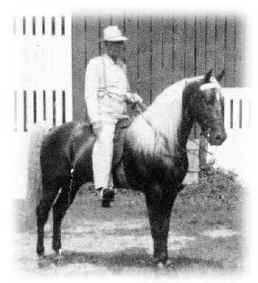
(#442761) stallion, sired in 1944, by Billie Wilson; Golden Mack
H. (#451889) stallion, foaled 1945, by
Last Chance; Handy Boy (#461926), stallion,
foaled 1946, by Last Chance; Sunny Boy H. (#520634), stallion,
foaled 1948, by Last Chance.
John A. Hendrixson was the breeder listed for all the foals from
'41-48.
Mandy B. (#410632), foaled in 1915 and also bred by
J. W. Simmons, was the third oldest yellow horse registered by the
Association. Records show she produced one black mare in 1929 for
Mr. Simmons, Simmon's Dollie (#410644) by
Roan Allen F-38.
Simmon's Dollie produced the two following yellow fillies by
Allen's Red Eagle for Mr. Simmons: Mary Eagle S. (#452679), foaled
1941, and Allen's Honey Lou (#442188), foaled 1942.
Della
Ersary was an early producer of yellow foals in the College Grove,
Tennessee area, having foaled the following four yellow foals:
Usrey's Della III (#441650), mare, foaled 1925, by Hall Bowers (by
Hal Summer F-7), B. A. Usrey, breeder; Della's Golden (#400944),
mare, foaled 1929, by Hunter's
Allen F-10, J. W. Covington, breeder; Golden Allen
(#350174), mare, foaled 1933, by Pruitt's Allen, Ben Ersary,
breeder; Cream Puff (#350174), mare, foaled 1935, by Major Allen,
J. V. Hyatt, breeder.
Golden Allen produced only one
chestnut foal; Cream Puff did not produce any foals.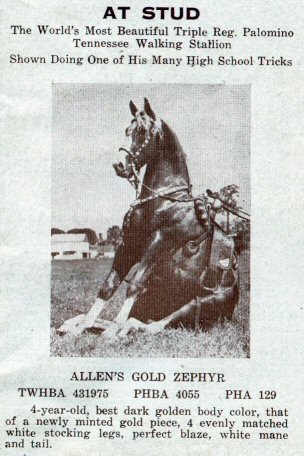
Usrey's Della III produced four foals, two of which were yellow
mares: Della Mack (#410173), foaled 1938, by Allen Red, and
Twilight Twinkle (#443513), foaled 1944, by Norris Allen. Lucille
P. Maxwell was the breeder of both foals.
Della's Golden
Patricia produced eight foals for J. W. Covington, five of which
were yellow. The first, Allen Parader (#400945), a stallion, was
sired by Golden Parader in 1937, the others were by Brantley's
Roan Allen Jr.: Golden Juanita (#411057), mare, foaled 1941;
Golden Anita (#432189), mare, foaled 1943; Golden Tornado
(#442817) stallion, foaled 1944; and Golden Rosita (#453279) mare,
foaled 1945.
Knowles
Rocksey (#390771), a yellow mare foaled in 1928, was bred by
Daniel Knowles of Sparta, Tennessee. She produced only five foals,
all were yellow: Queen White (#450862), mare, foaled 1933, by
Tennessee Valley Allen; Hendrixson Yellow Goldie (#390772), mare,
foaled 1937, by Pettit's Allen; Mountain May (#430452), mare,
foaled 1941, by Allen's Red Eagle; Rambler Golden Boy (#443998)
and Spiller's Gold Ace (#460148), both stallions, sired in 1944
and 1945, both by Wilson's Rambler.
Golden Sensation
(#441207), a yellow mare foaled in 1935, was bred by George B.
DeAtley of North Middleton, Kentucky. Her sire was Goebel
Copperbottom, untraced, and her dam was Kentucky Girl, untraced.
She produced Taxpayer (#420050), a yellow son.
Oakwood's
Golden Millions (#390097), a yellow mare foaled in 1936, was bred
by Pleas Hillis of McMinnville, Tennessee. She produced four foals
two of which were yellow. A mare and stallion, respectively, were
foaled in 1943 and 1944 for P. J. Fisher: Miss Golden Millions, by
Fisher's Wilson Allen, and Golden Millionaire, by Allen's
Supergold.
In studying pedigrees of early yellow horses
registered by the TWHBEASM, some are called
copperbottoms; they also trace to Mountain Slasher F-59, who
traces to Copperbottom.
Paul K. Fisher, Souderton,
Pennsylvania, advertised in the 1946 Blue Ribbon magazine as being
the world's largest breeder and dealer in yellow horses. He sold
Trigger Jr. (pictured on the lead page) to Roy Rogers. Trigger
Jr., registered as
Allen's Gold Zephyr,
was the most famous of all yellow horses. He was foaled in 1941;
his sire was
Barker's Moonbeam
(#380497) and his dam was Fisher's Gray Maud (#420776). He was
bred by C. O. Barker, Readyville, Tennessee.
Barker's Moonbeam was sired by
Golden Sunshine whose dam was
Golden Lady. All were palominos.
YELLOW CELEBRATION
COMPETITORS: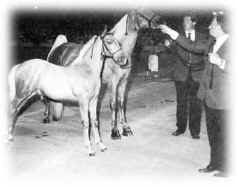
The following yellow horses placed in the Celebration from 1941 to
present: Golden Juanita (#411057), Yellow Fever (#442564), Invader
(#442644), Sun's Golden Girl (#490657), Mary Gold R. F. (#520560),
Golden Perfection H. (#561309), My Palomino Pal (#590653), Go
Boy's Yellow Chance (#632226), Goldfinger (#633371), Rising Sun
GLL (#641625), Delight's Desert Gold (#675688), Arthur J. Chance
(#622617), Golden Boy, Senator's Sunbeam (#721636), R. Golden Man
(#754985), Senator Solid Gold (#796621), The Platinum Blonde
(#820691), Goldie Wilson Allen (#715245), Gold Country (#842127),
Dapple's Gold Dream (#783856), Gold Fever (#701959), Crystal Creme
(#814074), Gen II (name changed to Generator's Golden Boy,
#880616), and The Genstar (#890304).
(Note: Mr. Givens
has done extensive research and has complete shows records on each
of these animals including placings, class, and year. We regret
that limited space prevented their inclusion, but, if you're
interested, he'd be delighted to supply you with this
information.)
Of these previous twenty-three yellow
show horses listed, thirteen trace to
Golden Lady
and twelve to Simmon's Mollie II. Three of them, My Palomino Pal,
Goldfinger, and Arthur J. Chance are by
John A's Chance and one, Golden Perfection H.,
from his dam. He was also the sire of Ann Last Chance, the dam of
Go Boy's Yellow Chance, Rising Sun GLL, and Senator's Sunbeam.
Furthermore, he was the sire of the second dam of Senator Solid
Gold and Gold Country.
John A's Chance
traces to Simmon's Mollie II.
The following five
Celebration ribbon winners had yellow dams: Nancy Ann Hendrixson
(#451888), Midnight Gold Sun (#481220), Mr. Trouble (#501357),
Champagne Lady Diane (#696266), and Go Boy's Creme Chance
(#741177).
The following three buckskin horses received
Celebration ribbons: Mr. Trouble (#501357), Las Vegas, and Go
Boy's Cream Chance.
Shadow's Royal Flush (#667465), who had
a buckskin dam by
John A's Chance,
was a black stallion that won five Celebration ribbons.
John A. Hendrixson, the breeder and owner of
John A's Chance, was
also the breeder of three yellow horses that were Celebration
winners.
Vance Paschal, 84, a life-time breeder and dealer
of yellow horses, said that John A's Chance was the best yellow
breeding stallion he had ever seen. Mr. Paschal of Readyville,
Tennessee, was the breeder of two yellow horses that were
Celebration ribbon winners.
Chance's Gold Dust H.
(#685726), owned by McAllen Finley, is the only known yellow
stallion still living by
John A's Chance.
Yellow horses
were in Spain in the 16th century. They were brought to Mexico,
then on into the western United States. They later reached middle
Tennessee, becoming intermingled with our native horses, resulting
as one of the colors of the Tennessee Walking Horses.
With
such a low percentage of all walking horses being yellow,
palominos have had a good show record. The records indicate that
most of the yellow show horses trace to
Golden Lady and Simmon's
Millie II.
John A's Chance sired more yellow show horses than any
one sire. His ancestors, close relatives, and descendants exhibit
outstanding show records. These records give weight to Mr.
Paschal's statement.
With the popularity of color
increasing in the Tennessee Walking Horse, the breeding and
raising of yellow horses should become more and more an integral
part of the industry.
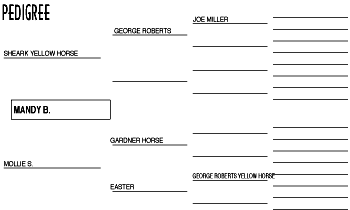
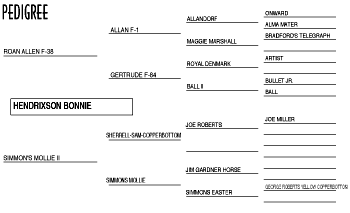
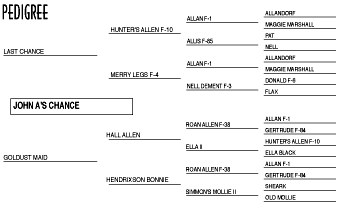 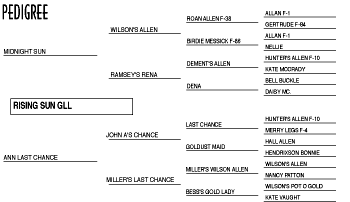
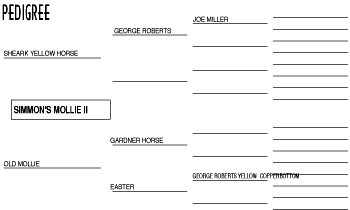 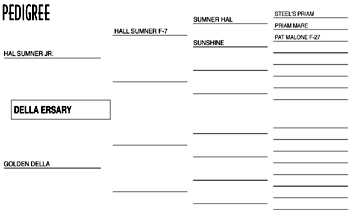
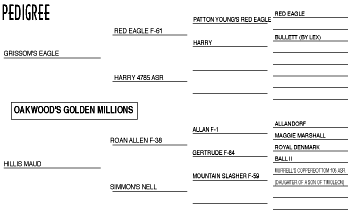 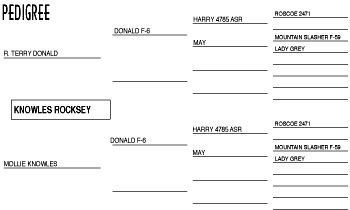
|